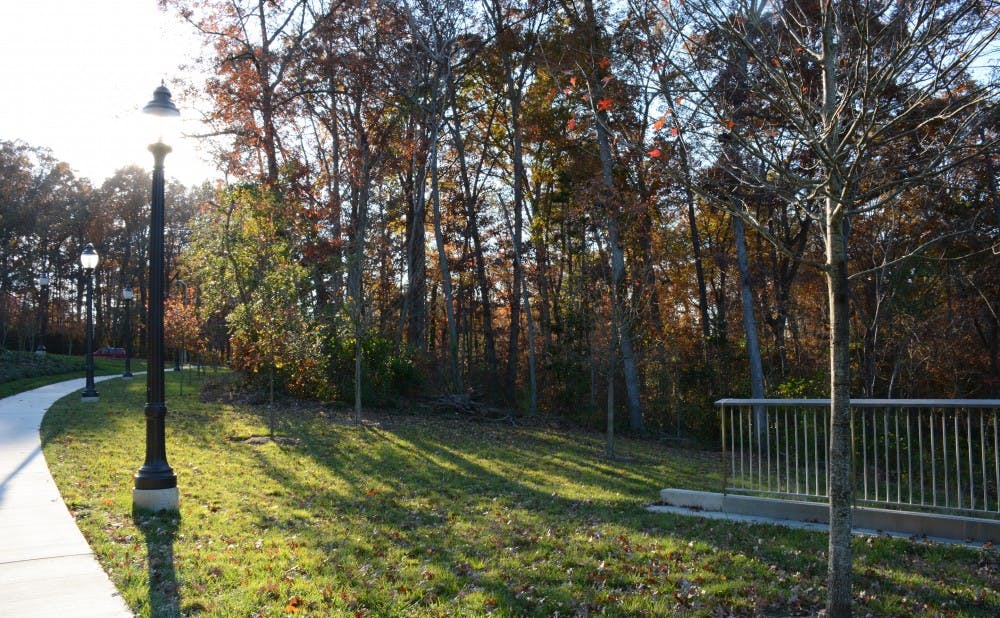Concerns over the location of the new Student Health and Wellness Center have created tension between administration and Duke faculty.
Scheduled to begin construction this coming February, the center will be located next to Penn Pavilion on the corner of Union Drive and Towerview Road in a portion of the Anderson Woods—named after Lewis Anderson, the late professor in the former botany department. The new center will house Counseling and Psychological Services, the Office of Case Management as well as Student Health and Wellness Center. Since the announcement of the University's plans to develop the area, concerns over the research and teaching values of the Anderson Woods have been raised among Duke faculty and Anderson's family members.
“The issue has to do with the siting of the new center on an area where there’s been a great deal of long-term research,” said Norm Christensen, professor emeritus in the division of environmental sciences and policy in the Nicholas School of the Environment.

The site was chosen by administration without much consultation with the representatives from the department of biology or the Nicholas School, Christensen said.
“I don’t know what happened in this case, but typically the University [consults involved groups] and is very careful about it and is very respectful of research being done. Something happened in the process and people weren’t notified and we didn’t learn of this project until a week ago, and we know that the timeline is short so we want to work quickly,” he said.
Executive Vice President Tallman Trask wrote in an email Friday that he has been in contact with concerned faculty, and is looking at alternatives.
“Still working thru the issue. Have been on the site with concerned faculty and we’re looking at alternatives,” Trask wrote, declining to comment further on the issue.
Modifications to the plans may be underway to try to mitigate the impacts of these developments on the forest, Christensen said.
“Some other faculty and myself met with several other faculty including Executive Vice President Trask and several other people to see if we can find a way to eliminate the conflict. That’s underway right now and it looks very promising,” he said.
The woods cover an area roughly the same size as Wallace Wade Stadium and are bound by Union Drive, Towerview Road, Science Drive and the Bryan Center. Home to many animals, the woods are also one of the few wooded areas on West Campus, Christensen explained.
In addition to its environmental values, the woods are also a critical teaching resource for biology courses, Christensen said. Several classes use the forest as an experimental learning tool.
“Here in the biology department we use the plot to teach ecology,” Bill Morris, professor of biology, said. “We take students across the street and its very convenient that it’s so close. We have them remeasure trees that were there 30 years ago analyze what changes have occurred. It’s one of the last remaining pieces of old-growth forest in the central part of campus.”
The new center will require approximately 25 percent of the forest to be chopped down. The impacts, however, go beyond the destruction of a few trees, Morris said. The ecological make-up of the forest could suffer damage from construction.
“Once you cut down the edge, you have sunlight penetrate deeper into the forest, which will make it unlike the center of a forest. It means that many non-native plants which need high light will invade because they’ll be able to take advantage of the greater light ability. Often when you build something, you bring in seeds that invade a site,” Morris said.
In the previous meeting between faculty and administrators concerning the issue, redesigns to the center were discussed, including making the building taller and eliminating some of its footprint.
The best alternative, Christensen said, was to move it in front of the Schwartz-Butters Athletic Center on Towerview Road—one of the sites originally proposed for the center. Christensen, however, acknowledged that at this stage in the planning, this is highly unlikely.
If the health center construction goes as planned, there are still some things that can be done to preserve the forest, Morris said.
“If they can’t re-site the center entirely, it would be helpful to think about some strategies to mitigate the impact on the woods,” said Morris. “Perhaps they could plant a row of evergreen trees that would prevent the sunlight from penetrating into the forest, or minimize the number of invasive plants which they bring in in the construction process.”
Morris also expressed a desire to prevent lapses in communication between the two groups in the future.
Get The Chronicle straight to your inbox
Sign up for our weekly newsletter. Cancel at any time.

